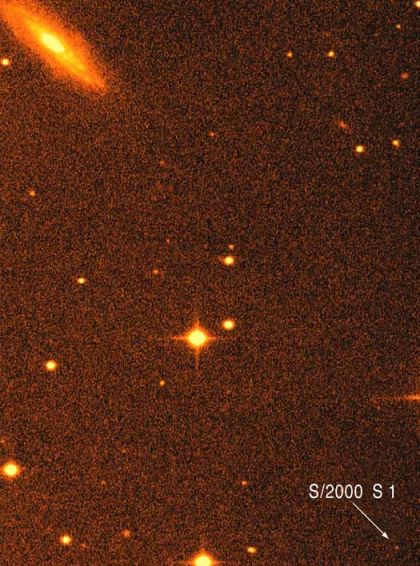
|
Credit & Copyright: B. Gladman
(Observatoire
de la Cote d'Azur) et al.,
European Southern Observatory
Explanation:
Which planet has the most moons?
For now, it's Saturn.
Four newly discovered
satellites bring the ringed planet's
total to twenty-two, just edging out
Uranus' twenty-one for
the most
known moons in the solar system.
Of course, the newfound
Saturnian
satellites are not
large and
photogenic.
The faint S/2000 S 1, the first discovered in the year 2000,
is the tiny dot indicated at the lower right of this
August 7th image made with the ESO 2.2 meter telescope at
La Silla, Chile.
(An eye-catching spiral galaxy at the upper left is in
the very distant background!)
Unlike Saturn's larger moons whose almost circular
orbits lie near the planet's equatorial plane,
all four newly discovered moons have
irregular,
skewed orbits drifting far from the planet.
With sizes in the 10 to 50 kilometer range, they are
are likely captured asteroids.
The international team of astronomers involved in the discoveries
hopes to get many observations of
the tiny satellites
allowing accurate orbital computations before
Saturn is
lost in the solar glare around March 2001.
The team has also found several other irregular satellite
candidates which are now being followed.
Saturn's only previously known irregular satellite is
Phoebe,
discovered over 100 years ago by W. H. Pickering,
European Southern Observatory
|
January February March April May June July August September October November December |
| ||||||||||||||||||||||||||||||||||||||||||||||||
NASA Web Site Statements, Warnings, and Disclaimers
NASA Official: Jay Norris. Specific rights apply.
A service of: LHEA at NASA / GSFC
& Michigan Tech. U.
Based on Astronomy Picture
Of the Day
Publications with keywords: Moon - Saturn - irregular moon
Publications with words: Moon - Saturn - irregular moon
See also:
